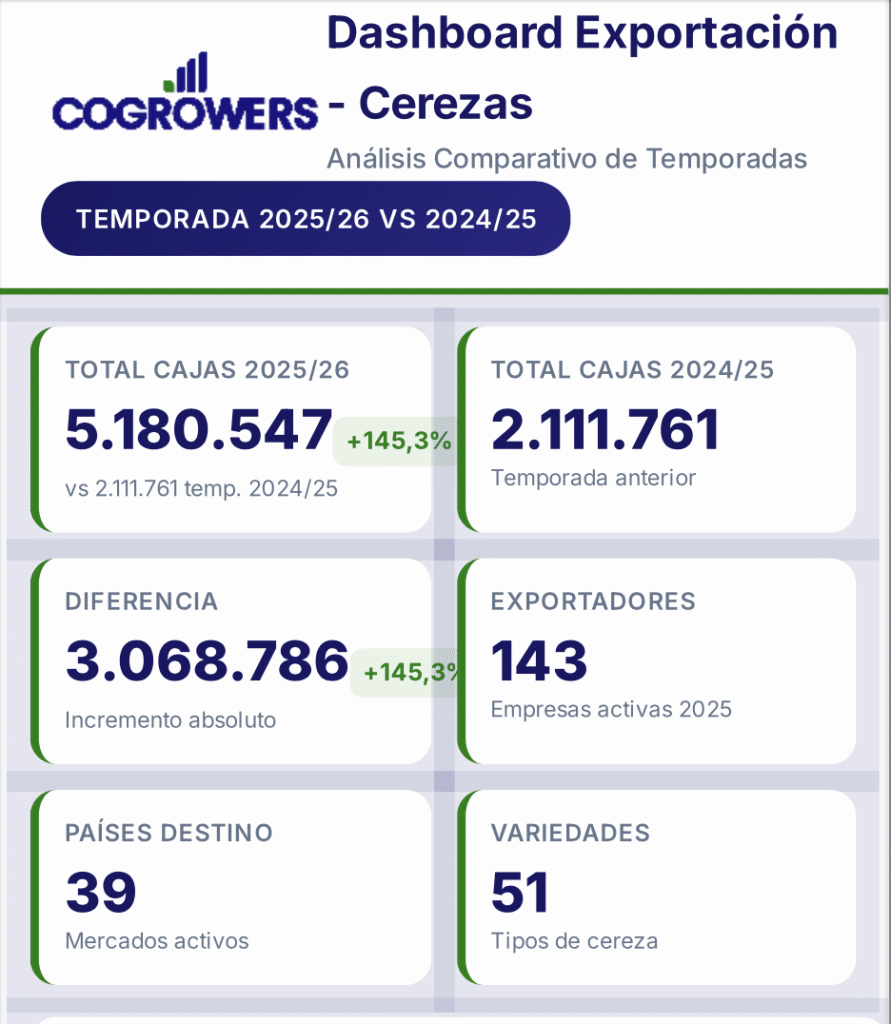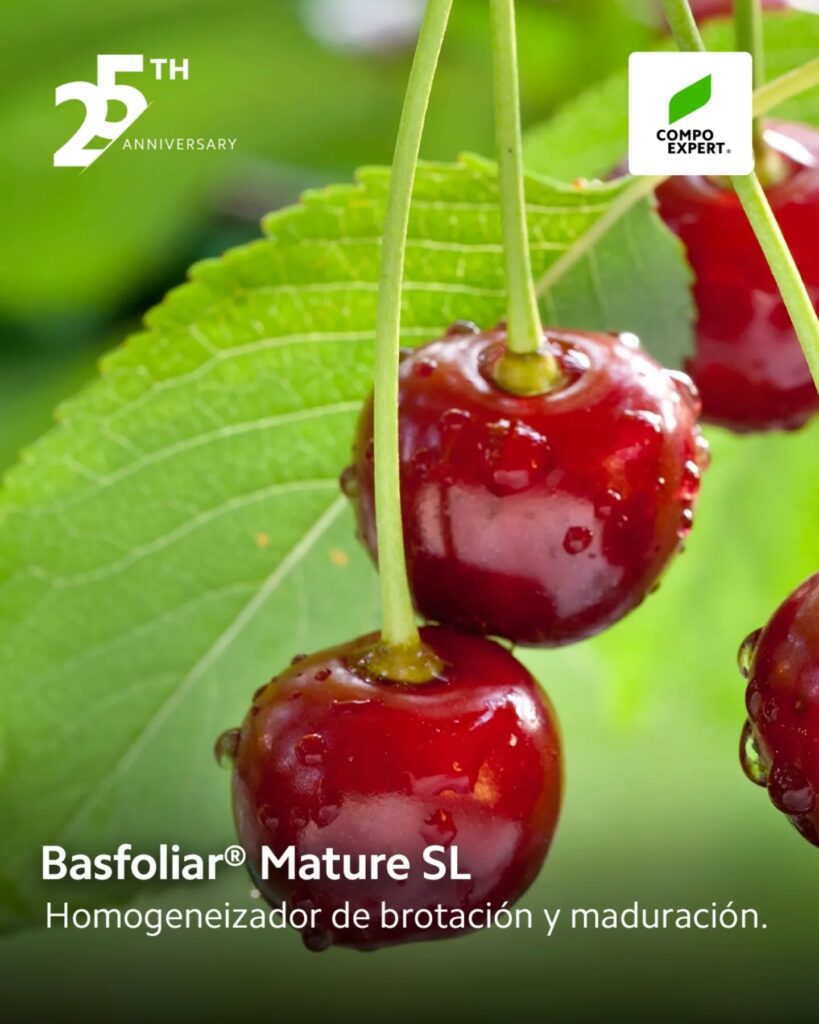We spoke with Eduardo Parra, technical manager of Greenhas Chile, who explained the keys to starting the process, the factors to consider and gave some recommendations for this stage of production to be successful.
This is a different season from last year, when we were in a hurry to get ahead, to get the fruit out as soon as possible, but this 2024 we will have a late new year, we could say. What is the outlook for this new cherry season that is coming?
Indeed, as you say, last season was a very urgent season, we were in a hurry to harvest early, the last ships left between December 10 and 11, so it was a very tight season. Very different from what is going to happen this season, since the Chinese New Year falls on February 10, which gives us 12 to 15 days difference with respect to last season.
So, in general terms, I think that this is a season, and thinking about dormancy breakers, not to advance so much but to homogenize a lot, stagger harvests, promote leaves, that will be the emphasis of dormancy breakers this season.

In addition, according to various models, it is predicted that it will be a winter with a fair amount of cold. Although it is true that it is a slightly rainier winter, which is what we all look for and expect, in general temperatures do not drop as much on rainy days. Therefore, from the point of view of the accumulation of cold hours, we will probably be fine, especially the varieties that require more cold. In short, strategically I think that it is a season in which we should leave the greatest amount of cold possible in the plants, in the orchards in a natural way. Therefore, we must interrupt or wake up these orchards as late as possible.
From that point of view, dormancy breakers during this season will be a little late compared to last year and probably the most affected will be the cyanamide variety, because there is probably not the urgency to advance so much where cyanamide is an excellent tool. So, this season we will take out cyanamide a little and these breakers will become more important.
There are a number of requirements that the orchard must meet in order to apply these dormancy breakers, including the accumulation of chilling hours. What happens if we apply a dormancy breaker without an optimal accumulation of chilling hours, according to each variety?
There are several things that we must take into account when applying a dormancy breaker. One of the main things is the accumulation of cold. We must have met at least 70% of the variety's cold requirement for the application of a dormancy breaker or cyanamide itself, which also has a minimum requirement of 70%. And another important thing is the health of the orchard, which is vital for choosing and thinking about the application of a dormancy breaker.
Having resolved the cold and the health of the orchard, obviously the technical and commercial conditions of the use of the products, one issue that we have left aside for a long time is the condition of the reserves that the orchard has.
I believe that this year, and this has been seen by many consultants and universities that have begun to work on the subject, it is extremely important to keep in mind that, just as we are concerned about the accumulation of cold, it is important to be concerned about the reserves of the orchard. Today we have tables, we have information, conditions to be able to sample, we have super suitable laboratories that can give us these reserve levels, I am talking mainly about sugars, starches and keeping that in mind we will have clarity about how our orchard is for the application of a breaker and the quality of flowering at the time of spring.
If we have a good accumulation of cold and a good accumulation of reserves, clearly the flowering will be better if one of these two factors is missing. So, if we keep in mind that if we lack cold or we lack reserves or we lack both conditions, the dormancy breaker comes to play a fundamental role in trying to mitigate the absence of one of these two factors, understanding that they are the two main factors that condition the quality of flowering. Therefore, if we lack one of the two factors that we have already mentioned, the dormancy breaker will be vital to homogenize the quality of flowering in spring, which is already diminished if the conditions of cold and reserve are not met.

You just mentioned that this season there will be a fair amount of cold hours, and there is an important factor: this winter is expected to be wetter than previous ones in the central region. However, temperatures are not so low when there is rain. What happens in this scenario?
A rainy year is beneficial on one hand and not so good on the other. It is very good because it helps to wash away various inhibitors that are in the soil at the root level. A rainy year, a good soil wash, will allow these inhibitors to allow the emergence of dormancy to be more homogeneous.
On the other hand, in a rainy year in Chile, temperatures generally do not drop much, so from the point of view of cold accumulation, in a rainy year it is less. Now, after the rain comes a period of low temperatures and that is where the accumulation can be compensated a little.
You just mentioned two factors: an accumulation of at least 70% of chill hours and the health of the orchard, which was essential for the application of dormancy breakers. What other aspects should we take into account when defining the dormancy-breaking strategy, whether it be dates or if it is going to be applied in tandem?
First, we must define what we are looking for with dormancy breakers. By definition, it is a product that is intended to homogenize flowering, to some extent advance harvests considering the application dates. The strength of any good dormancy breaker is homogenization, compaction and contributing to flowering. To determine this, the accumulation of cold is relevant, which must be at least 70%. The more it accumulates and hopefully it can exceed the 100% of the requirement, the greater the expression of a dormancy breaker will be.
The other thing is to keep in mind that when I apply a dormancy breaker and if I apply it in tandem with cyanamide, I am clearly looking to advance flowering and advance harvests. If that is my objective, clearly the combination of cyanamide with a dormancy breaker is the best alternative to achieve it.
Now, if I don't intend to apply dormancy breaker so early and I have a good accumulation of cold, I could do without the cyanamide and only apply the dormancy breaker. If this were the case, the advance in flowering and harvest would certainly be less. On the other hand, if I wait a little longer for the dormancy breaker and go outside the usual application schedule, which is at the end of July, and apply it in August, which is where we are most likely to go this season, and allow the garden to accumulate a little more cold, in general the harvest should not be advanced or if it is advanced, it will be one day, no more than that.
So we need to be very clear about the strategy we want to use: advance a lot, something in between or not advance at all. Depending on that, we can decide whether it is with cyanamide, without cyanamide or just the breaker in a later application.
Regarding the risks of bringing forward the harvest due to spring frosts, since we know that there are phenological states that are more sensitive, what is the recommendation?
We must bear this in mind. If my commercial strategy is to bring flowering forward a lot, because the variety I have has a good price, good early marketing and by virtue of that to apply cyanamide and breaker seeking that objective, we must bear in mind that we are going to flower in the first weeks of September, which historically in the central valley are areas with a high risk of frost. Therefore, if the decision was made to bring flowering forward a lot, we obviously have to have frost control in very good conditions and a state of alert.
If you had to make a recommendation for the application of dormancy breakers, given the current outlook for cold hours, considering how spring is projected, what would be your advice?
In general, this will be a season in which cyanamide will be on the decline or at least will remain stable. If one were to add the hectares in production that are susceptible to the application of cyanamide, it will probably compensate, but we do not see cyanamide increasing in any way. From that point of view, the application of dormancy breakers will increase and I think that this season will be applied a little later, waiting for the orchard to accumulate as much cold as possible.
The earliest varieties, which require less cold, will depend on the commercial strategy of each field. If it is indeed a matter of bringing the crops forward a lot, always keep in mind that there is an obvious risk of frost. So you have to pay attention to that, you have to have the equipment, the appropriate infrastructure to be able to carry out good control.
And let me give one last piece of advice that keeps coming up every year when we see all these applications. The main recommendation for a dormancy breaker to work properly is a good application and I mean that we have to keep in mind that dormancy breakers are applied in conjunction with calcium nitrate and many times this is where we make mistakes, where we normally see a bad application of calcium nitrate and when I refer to a bad application, it is the poor dissolution of the product.
In Chile, we have replaced the activators used worldwide with granulated calcium nitrate. One of the disadvantages of this product is its poor dissolution. It is difficult to dissolve and is applied at the end of July, beginning of August when we still have low temperatures, there is cold water and that makes the operation more difficult. Poor dissolution means that a large part of this product is not well dissolved and obviously not at the concentration that one seeks and the most dangerous thing about this poor application is that it will not be dissolved, it will remain deposited at the bottom of the machines and when it is applied in a high concentration, there is obviously a risk of burning basically due to the high causticity of calcium nitrate.
Therefore, the main recommendation, based on everything we see in the fields in Chile, is that the application of dormancy breakers associated with calcium nitrate, that the calcium nitrate is applied very well, that it is well dissolved at the concentration indicated by the product.
I would like to ask you about the different scenarios we have in Chile. Because we have cherries from Ovalle to Chile Chico and they are very different realities. I believe that in the north dormancy breakers are also used in very extreme situations. What could you tell us about this?
We must always keep in mind what we want to do and what we are looking for with dormancy breakers and keep in mind that at least the 70% cold requirement must be met.
If this requirement is not met, the use of cyanamide in tandem, after a dormancy breaker, becomes essential. Therefore, in the northern area we have varieties with lower cold requirements, but if eventually even 70% is not met, we will be dependent on the use of cyanamide to complement and somehow ensure that the dormancy breaker can exercise its full potential.
So, for the application of dormancy breakers, it is key to know what varieties I have, what my strategy is, if I want to advance a lot, a little or not at all, what the cold requirement is for those varieties and if at the time of application, I have met the 70% of the cold requirement. If I don't have it, I will be dependent on cyanamide, but if I meet that requirement, hopefully I can accumulate the greatest amount of cold naturally and apply the breaker looking for an intermediate advance or not at all, if I wait much longer and by virtue of that define what my strategy will be at the time of harvest, in the sense of advancing a lot, a little or not at all.
I insist, the health of the orchard is relevant, its condition, the varieties, the cold requirement, the winter conditions, whether there was actually a good accumulation or not and all these variables are put on the table to define the moment of application and whether we do a tandem with cyanamide or not.
At the beginning of this interview you mentioned that this season you would try to homogenize and not bring forward. I imagine that this decision regarding future planning also has to do with the ripening of the fruit, logistics, among other aspects.
That is the key. These products are not magic, the potential and where the product is justified is that it homogenizes flowering, shortens flowering, enhances fruit set, productivity, kilos, weight of fruit, etc. That is the objective for which this product is applied.
Now how you apply them is what is important, being clear about whether I want to advance a lot or a little, the cold requirement of that variety, if the orchard is very large or the plot is very large, obviously I have to partialize or apply in some sectors and not others, so that I can stagger the harvest, otherwise it would not make sense to have a large number of hectares harvested at the same time and that would complicate the logistics.
Nowadays, there are dormancy breakers that give us a certain flexibility of use, which means that I can apply it at the end of July and advance the harvest 3 to 4 days, and apply it in August and not advance anything and in that way stagger the harvest.
There are groundbreaking products that give us that flexibility, that plasticity of use, therefore, we must keep that in mind when choosing each one of them.







